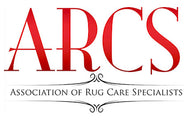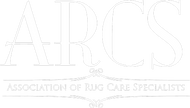March Newsletter 2017
1ST QUARTER NEWSLETTER
The ARCS Annual Convention is April 18-21, 2017 in San Antonio, TX.
We have a fantastic week planned for you. Upon arrival enjoy networking and happy hour overlooking the famous SA Riverwalk. Wednesday will be filled with experts discussing a variety of topics from how to create energy savings in your rug plant to Rug ID and Southwest Textile to how to better market your rug business.

A business coach from the BW Leadership Institute is flying down to speak about How to Build and Inspire Performance within your business! Thursday we will tour Aladdin, drink margaritas and check out some local rug related hot spots. Did I mention we will have several industry professionals (Centrum Force/Cobb Carpet Supply) showing off some of their amazing equipment and cleaning techniques? Friday, we have a private tour of the historic Alamo planned to end the Convention. - Randy Hyde, President ARCS
Enjoy Speakers and Demonstrations: Visit our website to register now!
What's in a Name? By Adam Dohanian
Rug ID has always been an important part of being a successful rug cleaner. Being able to accurately identify the rugs customers brought in for cleaning, as well as advising them to its age, origin, value, and condition have always been valuable and necessary skills. In the past, this knowledge was hard to come by; you had to have connections, usually a family member, to get an older cleaner or dealer to share their knowledge with you. Today the situation is different. There are a variety of classes that teach ID, and the Internet provides what seems like infinite resources for learning. Despite this, there are still aspects of rug ID that are sources of confusion, so in this article, I'd like to focus on something that has given me problems, and that is a vagueness in the labels given to older rugs.
I'll try to explain what I mean with an example. Recently, online, I saw a dealer advertise a rug with the description "late 19th century Karabagh (Eagle Kazak)". This description raises questions for me. Kazaks and Karabaghs both fit under the broader Caucasian rug label, but they describe two different regions and styles of weaving, so how can one rug be from two different places? Is one label correct and if so, why use the other one? What does the use of two labels tell us about the rug, and about the labels themselves? Is this dealer trying to cover for the fact that he doesn't know what the rug is? Will I figure out what this rug is before the Patriots win another Super Bowl?To answer these questions, it's helpful to back up a bit a look at where these names came from. Rugs have been woven and valued as beautiful furnishings for centuries, but they were deemed worthy of study only recently. Rugs, as well as tribal bags and other weavings, only began to be studied seriously and studiously in the 1960s and 1970s. There are rugs books that are older than this, of course, and some of them are very important and useful, but part of the reason they are notable is that they are relatively rare. In the 60s and 70s, there was a generation of people who were living and working in the Mid-East, going to bazaars, buying rugs and becoming curious about the weavers and the cultures that created these beautiful weavings they were seeing. They began to study these weavings and cultures in earnest and would write some of the seminal books on oriental rugs. Unfortunately, by this time the cultures that produced these great weavings were in deep decline so the amount of information available was limited. Today weaving cultures are studied by professional academics, and while we know much more now than in the 60s, there will probably always be gaps in our knowledge.
Obviously, while rugs have only been studied for a few decades, they have been valued, and sold, as home furnishings for much longer. The dealers who sold rugs had to give descriptions of what they had, so many of the labels that we use today originated in the trade. In a sense it's natural that this is the case; dealers, agents and pickers who went from village to village would know better than anyone where these weavings were made. The question is what purpose these labels served. Much of the rug trade was, and still is, dealer to dealer, not just dealer to customer, and before the Internet, getting pictures to examine was cumbersome , so often transactions came down to the reputation of the people involved and a conversation about the pieces involved. The descriptions were a way for people in the trade to communicate with each other about what they had. Does this mean the labels were inaccurate? Not necessarily, but they were often generalized, and they could change over time. A century ago formal rugs were popular, so there was more information about classical workshoprugs,butnotmuchaboutvillageandtribalweavings. Asinterestinother types of weavings increased, the labels given to these weavings often changed, often reflecting new research or interest in the "correct" label. As an example, the name Konya has often been used as a catch-all description of rugs woven in central Turkey. While rugs have been woven in Konya for a long time, there are many other villages in central Turkey where rugs of beauty and distinction that are different from Konya products were made but still labeled as Konya until recently, when these labels have become more specific. Are there labels more precise because we know more about rugs now? Maybe, I have no proof one way or the other, although I have a hard time believing that Turkish dealers from the 19th century couldn't identify these rugs with ease. A more plausible explanation is that there is more interest in the specific origins of rugs, so older, more general labels are now considered insufficient and are gradually replaced with more specific labels. Are these newer labels better? Generally, I believe the answer is yes, with a caveat. These new labels are again often originating from the trade, with other research contributing, so these labels could change again. Since no one wrote anything down about these weavings when they were actually being made, we're left with research which is incomplete we're trying to finish a puzzle and we're missing a bunch of pieces.
So we have rug labels that usually originated in the commercial rug trade, that have been subject to change, often to reflect new information or new interest in where weavings originated. That this leads to confusion is hardly surprising. The question is how do we make sense of it? Let's return to the example I started with, of a rug that's both a Kazak and a Karabagh. One of the most influential sources of Caucasian rug labels is a book written in the 60s by Ulrich Schurmann titled simply Caucasian Rugs. In it, Schurmann provides a specific naming system for different types of Caucasian rugs. The book was extremely popular; it had very high quality, for the time, color photographs of rugs that had not been in the spotlight before, and Schurmann labeling system became standard practice. Are the names accurate? No one really knows for sure, but some of his labels are based on design more than structure so there is skepticism. Having said that, most of his names are still widely used. In his book, one of the more striking designs belonged to what Schurmann called an Eagle Kazak. It has been a sought after type of rug ever since. However people had problems with the label he gave, the structure of these rugs is different from most Kazaks and eventually, a loose consensus was reached that these rugs probably came from the Karabagh region. So in regards to the rug I've been referencing, in today's parlance, the rug is a Karabagh, but there are still many people who think of it as an Eagle Kazak, so the dealer is trying to reach as many potential customers as possible.
As you're going through your rug ID courses and trying to become as knowledgeable as possible, I believe it's important to keep this perspective on where these labels come from in mind. I know once this point was made to me it helped clear up a lot of confusion.
Added note about recent CRS Class:

The CRS class was held in Dallas at Ellen Amirkhan's Oriental Rug Cleaning Co. from February 20th to the 25th. Ellen and Robert Mann taught the class which focused on rug ID. While any ARCS member can audit the class, those who wished to get their CRS designation had to pass a written test at the end of the class. Those who passed the test have until the end of the year to write a research paper that must be approved by the CRS committee to get their designation. All new CRS recipients will be announced next spring.

(Photos courtesy of recent CRS Class: Ellen Amirkhan and Robert Mann instructed the Association of Rug Care Specialists "Certified Rug Specialist" course at The Casbah at Oriental Rug Cleaning Co., Dallas, TX. Feb 20-25, 2017)
Rug Repair - Brand New Class!
Date: June 9-10, 2017
Location: Area Rug Cleaning Co. Detroit, Michigan
Randy and Val Hyde of Renaissance Rug Cleaning will teach this intense two day, hands-on repair class. They will take students through some of the most common repair techniques for cleaning businesses, including a variety of end and edge repairs, repairing splits, ways to hang rugs and more.
ICE Expo in Las Vegas, NV: ARCS Annual Skills Day - January 2017
The International Carpet Experts trade show was held in Las Vegas on January 26th and 27th. In conjunction with this, ARCS held an educational skills day on January 25th. Topics included rug ID, color stripping, tip shearing and various repair techniques. The skills day was attended by about seventy people, with more visiting the ARCS booth on the trade show floor. Attendees were happy and it was a great chance to catch up with old friends and make new ones.

ARCS Skills Day and several other programs at the ICE Expo In Las Vegas, NV were a success!

We want to thank everyone that participated and came to see us. We are looking forward to next year! Details are already in the works for 2018.




